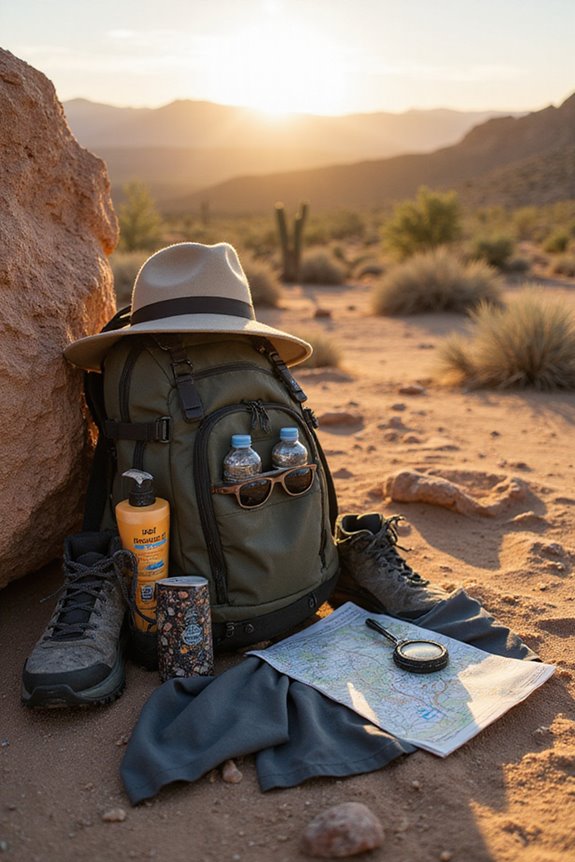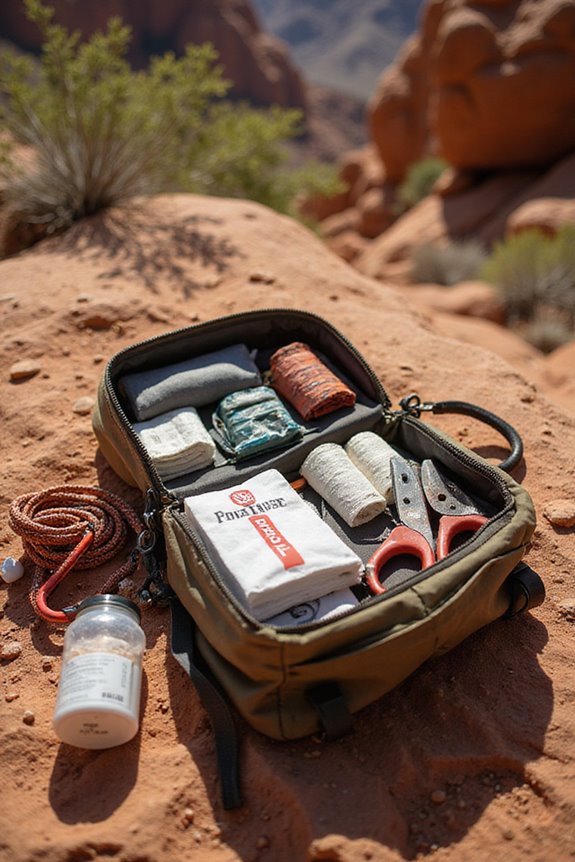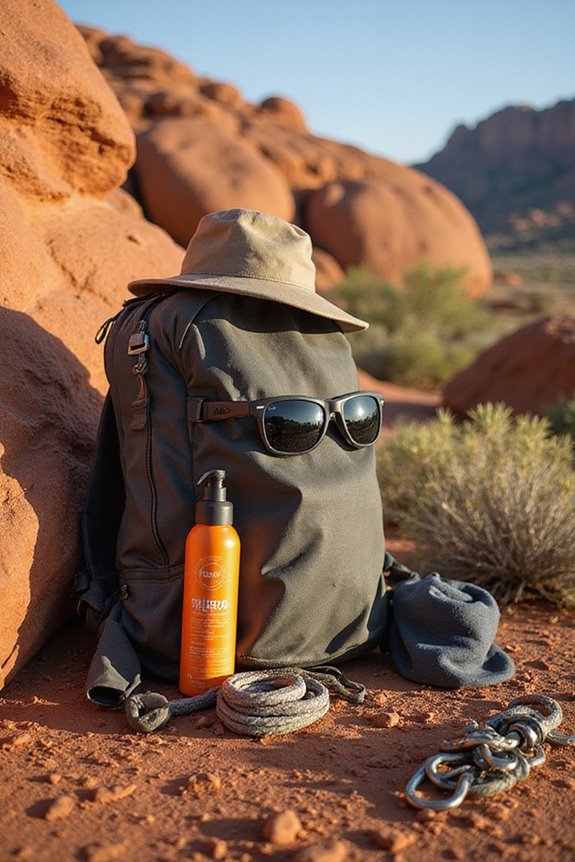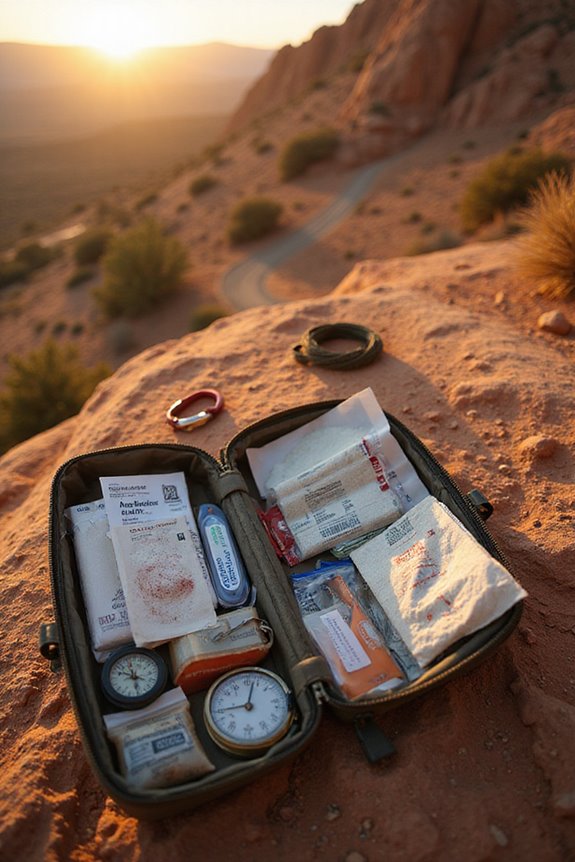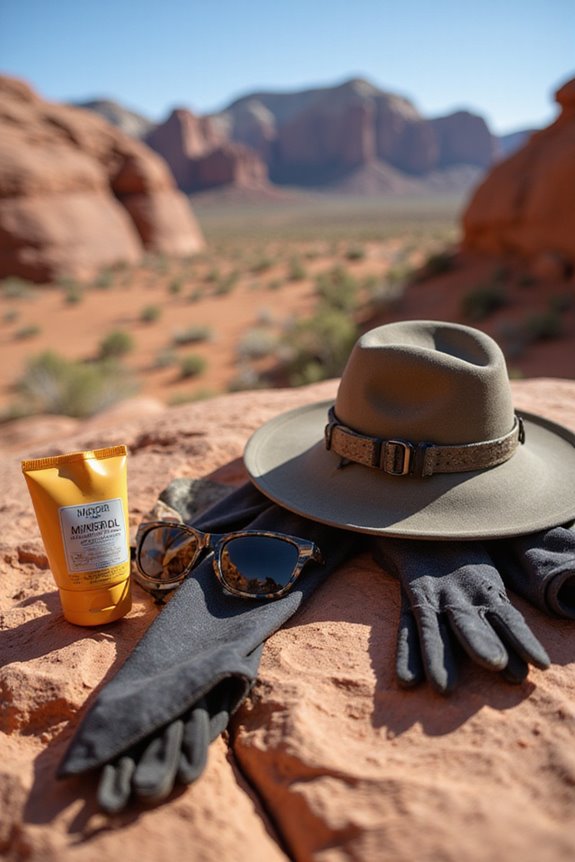When we’re gearing up for a desert wildlife adventure, we’ve got to be smart! Don’t forget polarized safety sunglasses for spotting critters and sturdy wide-brimmed hats for sun protection. We need breathable clothes and durable long-sleeve shirts to fend off those pesky cacti. Packing a bear-proof container for snacks is key—wildlife loves a good treat! And let’s make sure we’ve got plenty of water and reliable navigation tools. Trust me, it’s an amazing experience just waiting to unfold!
Key Takeaways
- Use bear-proof containers to securely store food, trash, and toiletries, preventing wildlife interactions.
- Pack polarized safety sunglasses and a wide-brimmed hat for sun protection and enhanced visibility.
- Bring breathable, light-colored clothing and long sleeve shirts made from durable fabrics for UV protection and comfort.
- Include a reliable GPS device and binoculars to aid in navigation and wildlife observation.
- Carry sufficient water (at least one gallon per day) and a survival first aid kit for emergencies.
Essential Personal Protective Equipment (PPE)
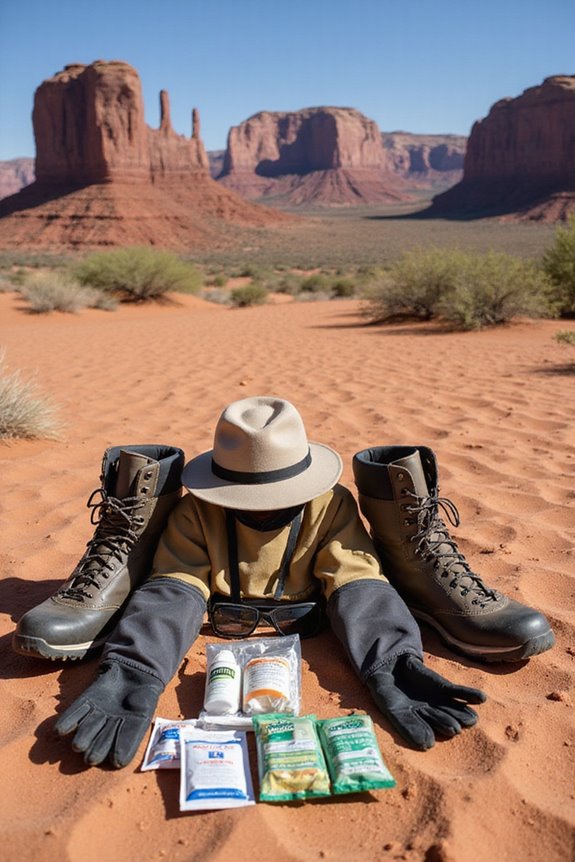
When we’re gearing up for a desert adventure, personal protective equipment (PPE) is our first line of defense. We realize firsthand the importance of keeping those peepers safe, so polarized safety sunglasses are a must! They not only shield our eyes from that blazing sun but also help us spot wildlife in the shimmering heat.
Let’s talk clothing durability—long sleeve shirts made from tough fabric like denim protect us from pesky thorns and harmful sun rays. Throw on some breathable, light-colored gear to keep cool while we explore. And let’s not forget a sturdy hat with a wide brim to fend off the sun! Opt for a hat with UPF 50 protection that blocks 98% of harmful UV rays while providing proper ventilation through mesh panels. Trust us, a little precaution goes a long way in ensuring our freedom on the trails!
Food and Scented Item Storage
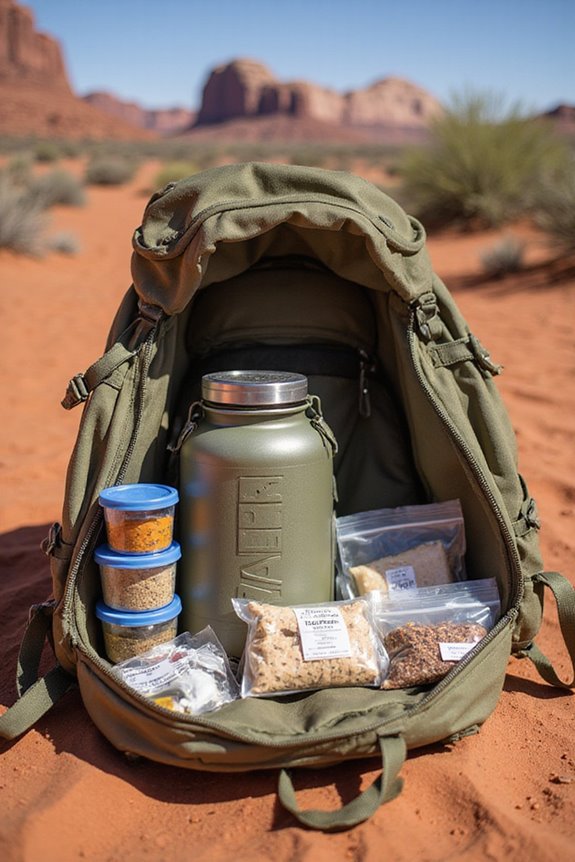
After gearing up with the right PPE, we can’t overlook how to keep our food and scented items safe from curious desert wildlife. Let’s be real—nothing gets a critter’s attention quite like food canisters packed with tasty treats! To dodge those wildlife attractants, we need to stow all snacks, trash, and toiletries in bear-proof containers or metal bear lockers when we hit the sack. Hanging food bags is a classic, but in the desert, that might feel like a circus act. Remember, even our scented lip balm can lure in the locals! Adding a survival first aid kit with organized compartments allows for quick access during unexpected wildlife encounters. By securing everything tightly, we keep wild encounters at bay—ensuring our camp remains peaceful and adventurous. Happy trails, friends!
Camping Gear and Setup
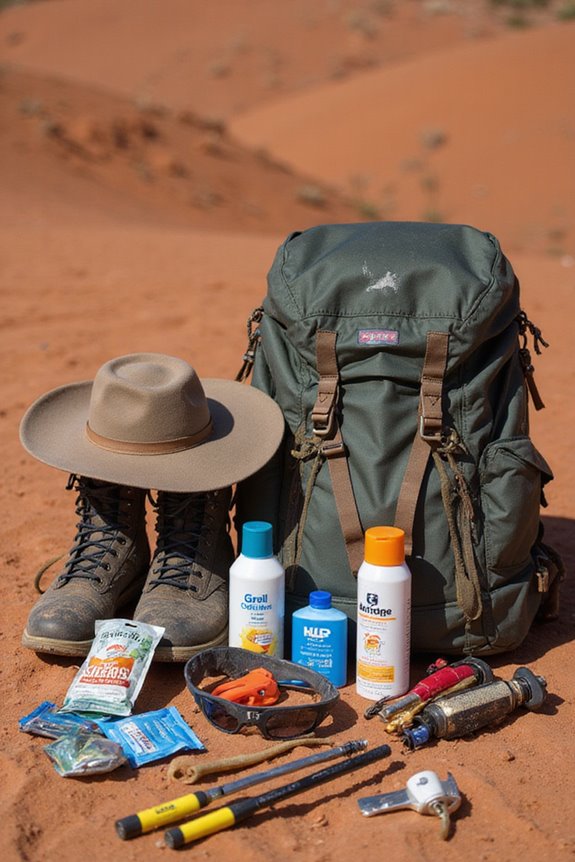
As we gear up for our desert adventure, let’s plunge into the essentials of camping gear and setup. First off, our tent selection is vital—choose a well-ventilated, lightweight tent with UV protection. Don’t forget the rainfly for unexpected storms; after all, desert weather can be as unpredictable as a coyote’s midnight howl! Look for tents with waterproof rating 3000mm or higher to ensure protection during flash desert rainstorms. For a comfy sleep, let’s pack those insulating sleeping pads and warm layers to combat chilly nights. Now, when the sun goes down, our lighting setup becomes a lifesaver. A reliable headlamp and some solar lanterns will keep the campsite glowing without draining our packs. So, let’s hit the desert with the right gear; adventure awaits, and we’ve got this!
Navigation and Observation Tools
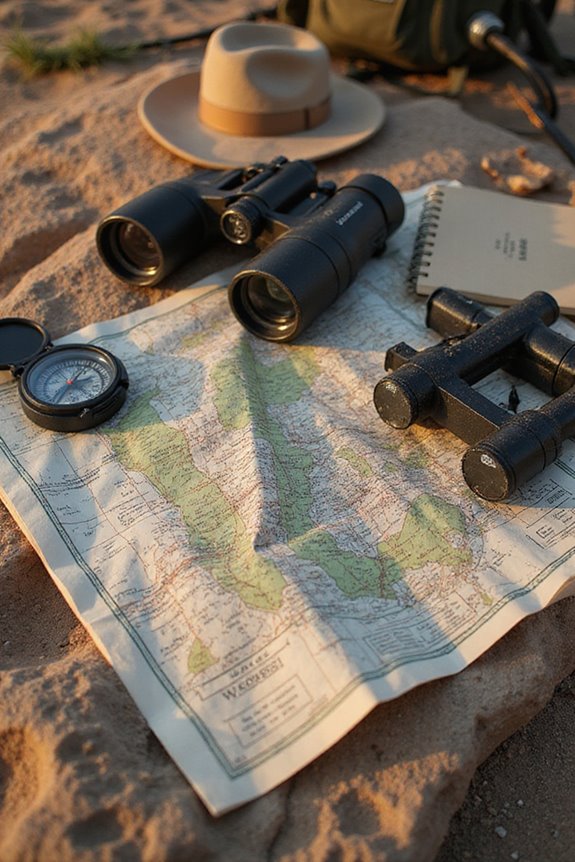
Setting up camp in the desert is just the beginning of our adventure! To make the most of our experience, we need trusty navigation and observation tools—think GPS devices and compact binoculars. A good GPS unit not only helps us stay on track in that endless landscape but also records waypoints for a safe return; trust me, we don’t want to play hide and seek with the sun! For serious desert adventures, consider a Garmin GPSMAP 67i which combines rugged design with satellite communication capabilities for emergency situations in remote areas.
When it comes to wildlife spotting, binocular usage is essential. Opt for 8× to 10× magnification to glimpse distant creatures without breaking our backs carrying heavy gear. And if we venture out at dawn or dusk? Waterproof binoculars with enhanced low-light capability guarantee we don’t miss that elusive desert drama. Let’s explore!
Hydration and Sun Protection Essentials
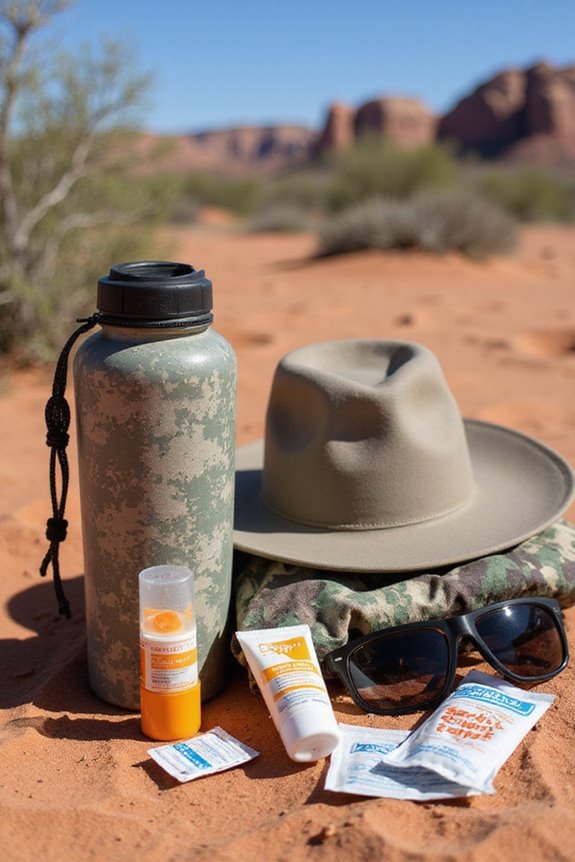
When we hit the trail in the blistering desert sun, it’s not just about the adventure; hydration and sun protection are our top priorities! Let’s make sure to pack at least a gallon of water per day, and hydration packs make sipping on the go a breeze. We’ll want to drink regularly, even when we’re not thirsty—trust me, that’s essential for staying sharp!
For sun protection, light-colored, loose-fitting clothes work wonders, and don’t forget that wide-brimmed hat and UV-blocking sunglasses! I’ve learned the hard way how vital sunscreen is—don’t skip it. Let’s throw in some emergency shade gear, too. After all, we want our desert adventure to be fun in the sun, not a sunburned slog! Hiking shirts with UPF 50+ protection are essential for shielding your skin from harmful UV rays during long desert excursions.
Frequently Asked Questions
What First Aid Supplies Should I Include for Wildlife Encounters?
For wildlife encounters, let’s guarantee our first aid kit’s stocked with essentials. We’ll need antiseptics, gauze, pain relievers, and insect bite remedies. Being prepared keeps our adventurous spirit alive and ready for anything nature throws our way!
How Can I Identify Venomous Snakes in the Desert?
When identifying venomous desert snake species, we should look for key features like triangular heads and rattles. By knowing these snake identification tips, we can enjoy the desert safely and embrace our freedom without fear.
Are There Specific Plants to Avoid While Hiking?
When we wander through deserts, we must beware of lurking cacti dangers and toxic shrubs. They’re not just plants; they’re nature’s treacherous traps. Let’s tread carefully, embracing the freedom of exploration while staying safe!
What Should I Do if I Encounter a Wild Animal?
When we face a wild animal, let’s follow animal encounter protocols: keep distance, stay calm, and observe quietly. Applying wildlife observation tips helps us appreciate nature while ensuring our safety and the animals’ well-being.
How Can I Minimize Noise to Avoid Attracting Wildlife?
When we’re out exploring, let’s embrace our inner monks—practicing noise reduction helps us enhance wildlife awareness. By moving quietly and respecting the soundscape, we can appreciate nature without startling its residents. Let’s tread softly together!

